Types of Sweet Bread: Ultimate List
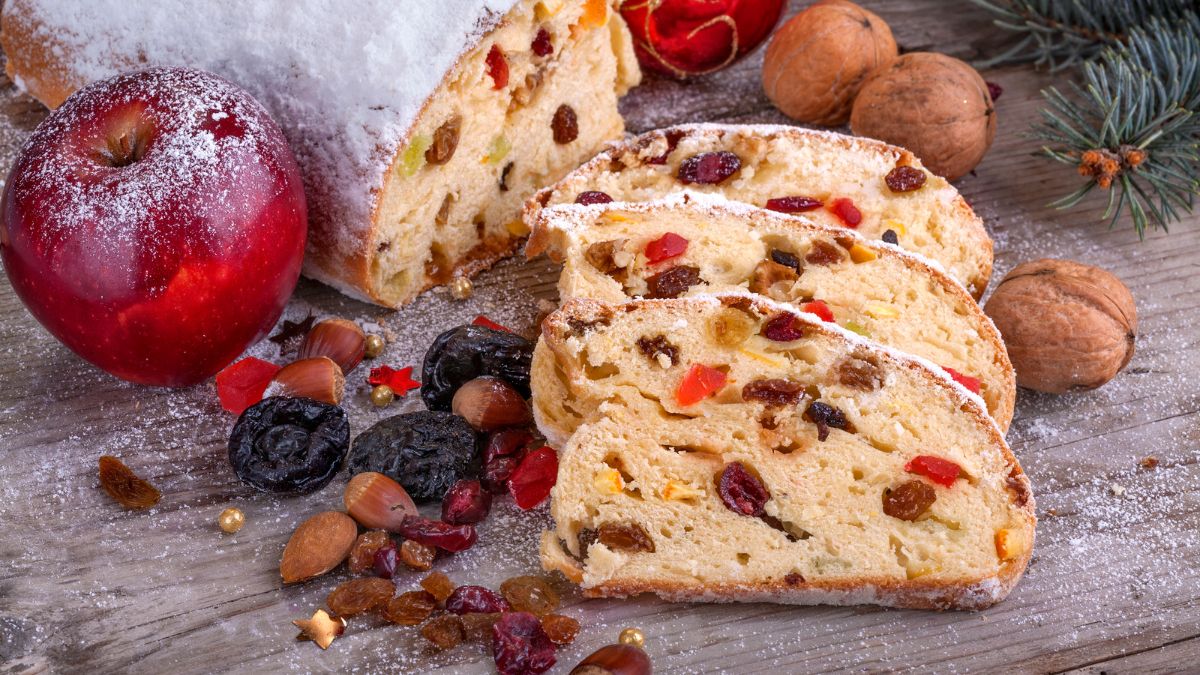
Growing up in a family that eats bread for every meal, I have learned that you don’t need to give up bread, even for dessert. The combinations are endless, from simple, plain, and slightly sweetened loaves to rich, cake-like bread. Also, if you like to learn new things, people say the best way to know one’s culture is to learn about their cuisine. So, here is a worldwide list of all types of sweet bread.
There are numerous varieties between the most popular American banana bread and Japanese anpan: brioche, stollen, cinnamon or cardamom loaf, panettone, and Hawaiian bread. Some are based on fluffiness provided by white flour, yeast, and milk, while some are packed with whole grains, nuts, and dried fruits.
I will surely never be able to try every sweet bread recipe, but I won’t run from new flavors. There are so many combinations I would never think of, but that’s why this is an ultimate list. Let’s go on the gastro-cruise through the world!
List of Types of Sweet Bread
The list isn’t complete, and I doubt it will ever be. But hey, here is still a very long list of ideas and entries for the most mouth-watering ones. Tastes differ, so keep reading to get an idea of your favorite.
Banana Bread
American favorite from the 1930s, banana bread became the world’s most famous sweet bread. It comes in hundreds of combinations and variations, to the point where the banana is the only ingredient that isn’t replaced. You can make it with a few basic ingredients or add oh-so-many things to its mixture.
In the last few years, banana bread skyrocketed because of the popularization of the diet culture. Flourless, gluten-free, dairy-free, and sugar-free sweet bread but still moist and nutritional, that’s everything banana bread can be. Just mix banana with the components of your choice and enjoy the taste.
Always choose ripe bananas, as they have more sugar and dampness, so you’ll end up with moist bread. Moreover, add chocolate chunks, nuts, cocoa, cinnamon, caramel, vanilla, dried fruits, or anything else that comes to your mind. Basic ingredients, besides bananas, are flour, milk, eggs, and baking powder.
Of course, banana bread has an intense banana flavor, and it is succulent and tender, yet crunchy if you add nuts and choco or caramel chunks. It’s soft on the inside but has a crispy crust. The best thing about banana loaf is that it can make a splendid choice for a nutritious breakfast.
You can replace sugar with honey, agave syrup, non-nutritive sweetener, stevia, and all-purpose flour with ground seeds or whole-grain flour. Possibilities are endless, as you can see. I like to add some grated zucchini to make the moistness burst.
Brioche
Brioche is a lightweight French pastry that abounds in eggs and butter. It is soft and slightly puffy inside but has a golden-brown, crispy crust. Brioche has a breathable texture because of yeast, sourdough, and loads of eggs, butter, and milk.
Add brandy for a real holiday smack if you like a bit edgier taste. Moreover, replace milk with heavy cream or whole milk. You can add vanilla, cinnamon, ginger, or dried fruits. For a pinch of zest, add grated lemon or orange peel, plus you can make lemon-based icing for a cool aftertaste.
For a festive look, you can garnish the pastry with candied fruits, like slices of orange and cranberry. You can also fill it with smooth, buttery vanilla and lemon cream. There are many variations, so do a little research and pick your fav!
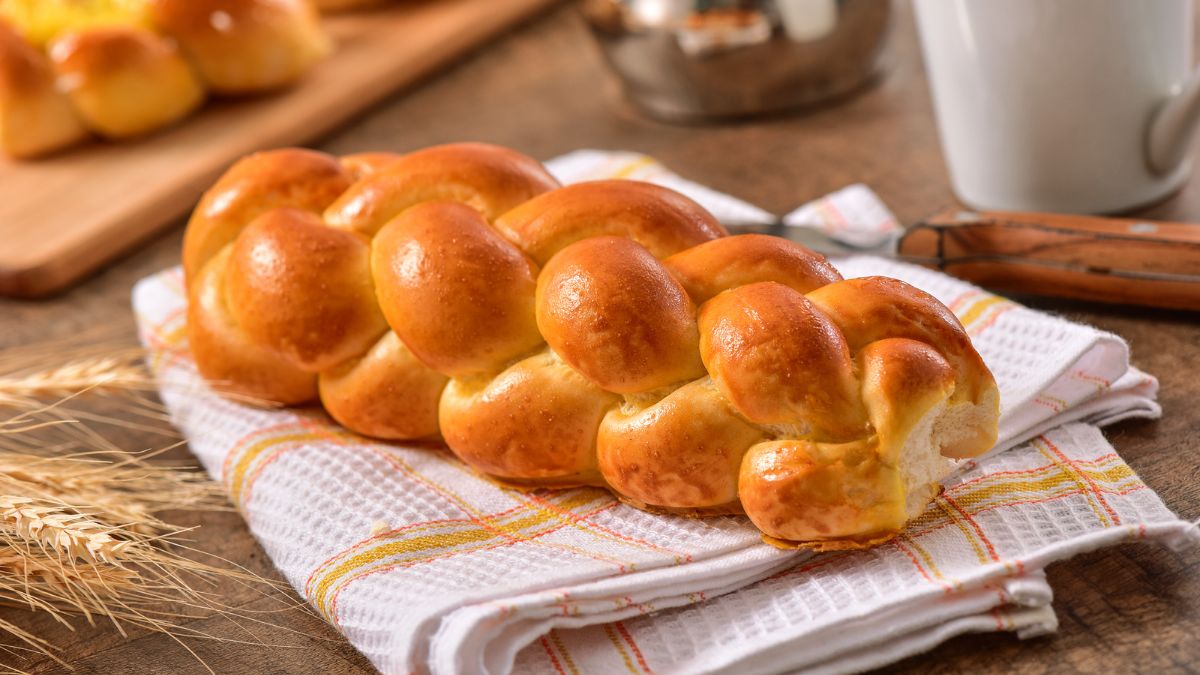
Cinnamon Roll
This is not a classic bread, but rolled dough sliced into circles. It has bread-like consistency, though. That’s why we can count it in this list. It is the messenger of autumn, served with hot tea and cooked wine, especially popular in Scandinavia and North America.
The dough is the simplest ever: flour, yeast, eggs, and warm milk kneaded till smooth and fluffy. You can only fill it with cinnamon, brown sugar, and butter. It will be squishy with a crispy golden crust. Make a confection sugar-based icing, and add some cream cheese or vanilla for the best taste.
Kulich
Kulich is Russian Easter bred, very tall, iced, and sprinkled on the top. Tradition orders to put it in a brushwood basket and decorate it with colorful spring flowers and dyed eggs. Russians bake it in tin-like pans, so they resemble Italian panettone.
When it comes to textures, kulich is thicker and weighs more. Cheese Paskha is a traditional Eastern dish, too, that pairs perfectly with this bread. It is packed with eggs and butter, so it has a complex taste that will rocket you to your childhood. Sweet aroma will linger in your home for days after baking it!
Cozonac
The well-kept tradition of Bulgaria and Romania, cozonac is an uninventable part of holiday tables. You’ll see them on tables of Southeastern European countries, typically at Easter time. It comes two ways: like a loaf mixed with raisins or rolled out and filled with poppy seeds and walnut paste.
The dough is soft and mouth-melting as it has a base made of milk, eggs, and butter. They usually add rum, orange, lemon zest, or vanilla to upgrade this basic dough. The advice is to add some milk to the paste you’ll use for filling and let it sit a bit so the nuts won’t crumble.
Vánočka
Vánočka is a traditional Slovakian and Chezch Christmas loaf. It’s pretty tricky to make, so that’s the reason why you make it for special occasions only. It is similar to brioche in taste, though, as you need the same base ingredients: flour, eggs, yeast, and butter.
It has an eye-catching look, as it’s a pleated loaf, and you definitely need a little bit of skill to make it. The dough is basic, so they enrich it with raisins and roughly chopped almonds. For a touch of zest, there’s grated lemon peel and a few drops of rum (or more) for a more festive mood.
Stollen
This is a traditional Christmas bread too, but this one originates from Germany. Interestingly, this loaf is low in sugar, but the bar rises when you add dried or candied fruits which are a must for the best taste. Stollen is a fruit loaf; you just need to pick which ones you want to add.
So, Germans usually add candied lemon or orange peel for tart flavor. Almonds, raisins, apricots, dried fruit, or nuts are welcome. You can boost its flavors with winter spices like cardamom, cinnamon, nutmeg, and rum. Don’t be surprised if you find marzipan in the list of ingredients, too.
Another plus thing is that stollen looks very interesting when sliced because of the different vibrant colors of dried or candied fruits, like apricots, cherries, currants, flame, or golden raisins, lemon, and orange. Cover it generously with confection sugar as it represents the snowy landscapes of Germany.
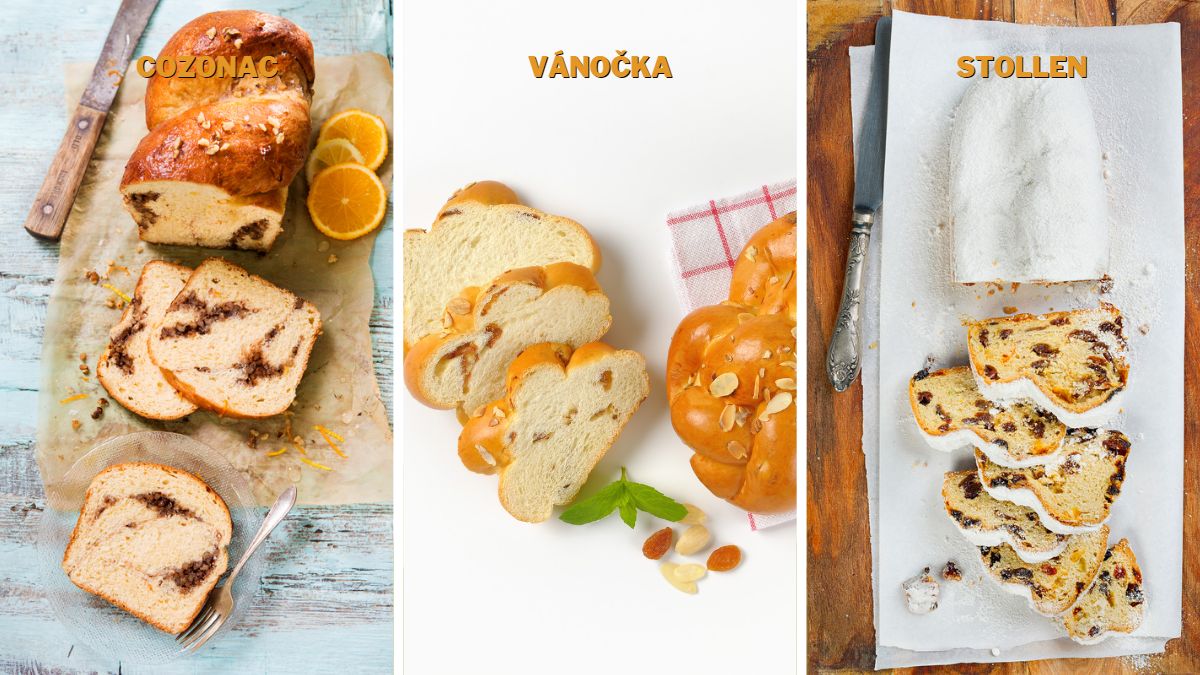
Challah
Challah is a braided loaf, similar to Ester Europian Vánočka, but has Jewish roots. Jewish people make it for major holidays, and it has a magnificent religious stronghold. If you want to hold onto the tradition, make a loaf of flour, water, sugar, yeast, and eggs.
You can also replace regular flour with whole-grain and sugar with honey or molasses. Raisins and saffron are not unusual ingredients whatsoever. Before baking, you’ll also need poppy or sesame seeds to sprinkle over the loaf.
Bisciola
Born in the Italian region of Lombardy, bisciola is an irreplaceable part of the Christmas table. This rustic bread loaf is solid and crunchy with a sweet aroma. You can eat it at room temperature or slightly warmed with a cup of cooked wine.
Traditional bisciola requires natural sourdough and rye flour when it comes to preparation. You can replace rye with wheat, whole wheat, or buckwheat flour and mix it with butter, milk, sugar, and yeast. The fun part comes: add dried fruit and nuts to the blend.
Dried figs are the chief ingredient, but don’t skip candied citron, orange, walnuts, almonds, pine nuts, raisins, or dried apricots. My favorite combo is to add honey and chunks of dark chocolate, and here you’ll have to try different blends to see what’s your fav. Nuts and fruit pastries don’t just taste heavenly, but they are also very appealing when served up.
Panettone
Panettone is one more Italian sweet bread, similar in taste but shaped differently. It originates from Milan and is the central piece of Christmas and New Year’s Eve tables. You can buy it in every Italian market wrapped in decorative holiday paper.
Panetone is eye-catching, high, and cupola-shaped sweat bread, pretty fluffy in texture. You can add the same ingredients in the mixture, like in bisciola, dried, candied fruits, and even chestnuts or chocolate. Whether naked, sprinkled with powdered sugar, or topped with a mixture of mascarpone and liquor, it will be equally delish.
This fruitcake goes along with sweet wines and sweet hot drinks like tea or coffee if you want to stay alcohol-free. In my family, no holiday goes by without it on the table.
Pandoro
Another dash of Italian Christmas and New Year’s Eve tradition, but this one comes from Verona. It is high, like a panettone but star-shaped. Interestingly, the peaks of that “star “resemble crests of the Italian Alps, and dusted vanilla-flavored powder sugar represents snow. It has just a few base ingredients, without additions, unlike panettone and bisciola.
It has a smooth and velvety texture, a vanilla-induced aroma, and a rich taste because of butter and eggs. Moreover, it’s ideal for decorating with chocolate, mascarpone, or cream for that simple flavor. Pandoro is golden on the outside but buttery inside and worth tasting.
Pain D’épices
This is a gem of French cuisine — a quick sweet bread that requires baking soda. It tastes similar to gingerbread because you need almost the same ingredients. The base is rye flour, honey, and spices.
Blend cinnamon, ginger, clove, and nutmeg for a real festive delish. Devour it with a cup of coffee or hot tea to magnify these spices to the top. You can cover it with candied fruit or cream for a more cake-like feeling.
Anpan
Anpan is a Japanese delicacy – a bun filled with azuki red bean pasta. It is also very popular in China and Korea, but in the West, it became voguish after the expansion of K-pop music and anime.
The bun is fluffy and soft, while the paste is buttery but slightly granular. When it comes to the taste, red azuki is on the sweet side, with an earthy note, similar to sweet potatoes. Anko (short for red bean paste) requires adding sugar while cooking the beans and mashing them at the end, though.
On the cross-section, it looks like a chocolate doughnut, with a soft bun and thick filling on the inside. The bun has the usual recipe, flour, yeast, and warm milk, washed in the yolk for a golden-brown look. You’ll also need a pinch of sesame seeds to sprinkle. It’s undoubtedly worth trying, plus you need to bake them, not deep fry them.

Mosbolletjies
For a dash of South Africa, bake these buns. It’s soft with a deep-golden crust, which comes from all-purpose flour, yeast, milk, and butter. What makes it exceptional is the addition of grape juice to the dough; that’s why it was traditionally made only in the wine-making season.
The enchanting aroma comes from aniseed, and if you want a softer crust, smear it with butter after baking. It is similar to brioche, whatsoever. When speaking of serving, you can bake it as one larger loaf or divide it into smaller buns, plus you can eat it solo or with some homemade jam, for example. Yum!
Boston Bun
This is a spicy bun, rich in coconut icing, popular in Australia and New Zealand. Unlike previous sweat bread types, it contains mashed potato in its dough. Other ingredients are wheat flour, yeast, milk, and sugar, so you’ll get a moist, soft dough.
It’s not strange to see dried fruits and some spices in the recipe, like sultanas or mixed spices. You can also add some food coloring to the coconut icing to make it more interesting on the table. Boston bun is a superb pastry to serve with afternoon tea, so this is your sign of gathering everyone for a tea party!
Cardamom Bread
Cardamom alone is extremely popular in Nordic countries, so it’s no surprise that cardamom bread is among the favorite pastries. They eat it throughout the whole year, served with tea or coffee. It can be in various shapes, from simple round to braided loaf and everything in between.
The dough is basic, flour, sugar, butter, and warm milk for softness, and yeast for puffiness. Ground cardamom then gives it a piny and fruity note, making it trés aromatic. You can add raisins or almonds to the dough, too. My grandma always coats the loaf in the egg for a shiny glaze and sprinkles it with walnuts, almond flakes, sugar, or vanilla icing for a finishing touch.
Pineapple Bun
These are top-tier in Hong Kong and Chinatowns all around the world. It is on Hong Kong’s intangible cultural heritage list, though. You may be surprised, but the pineapple bun doesn’t contain pineapple. The name comes from the fact that the crust looks similar to the exocarp of a pineapple.
The top of the pineapple bun contains flour, sugar, eggs, and lard. It is sugary and crispy in texture. When it comes to the bread dough underneath, it is classical Hong Kong-style dough, mushier and more sweetened than Western bread types. It’s a typical part of the breakfast or the fab pastry with the afternoon tea.
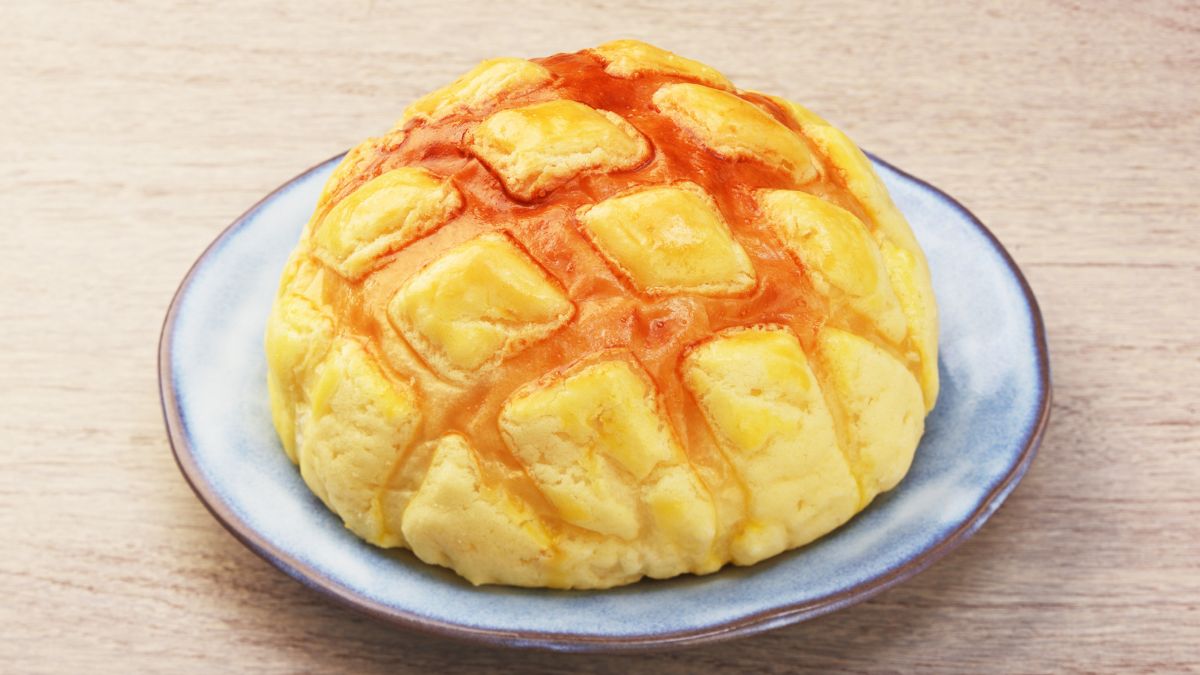
Hawaiian Bread
This bread has pineapple juice in its ingredient list and mashed potato flakes for moistness. Other ingredients are usual, plus vanilla, for a sweet base note. It is yeast-based, so it needs to rise, but it will be madly soft.
It comes in two most common shapes-loaf or round. It is easy to cut in slices, or you can make them Kaiser-like for easier serving. They go along with cream cheese or even prosciutto for a contrast.
Tsoureki
Tsoureki is a Greek holiday bread, but it has its versions in the Arab world, Armenia, Azerbaijan, Albania, Bulgaria, Romania, and Turkey. The base is pretty much the same as in the rest of these sweet bread loaves, but the seasoning is pretty special. Tsoureki has a particular aftertaste, as added orange zest, mastic resin, or mahlab give it a bit of zestiness.
Greeks make it for Easter and press red-dyed Easter eggs into the bread. If you don’t like sharp flavors, you can replace them with almond extract, cinnamon, or sultanas. It has a dark-golden brownish shiny coat because of the egg yolk wash. You can garnish it with silvered hazelnuts or sesame seeds.
Then, if you decide to prepare it for Christmas, be free to add dried fruit mix: raisins, apricots, and figs, plus winter spices. Moreover, glaze it with a blend of honey and orange juice, and decorate it with whole walnuts.
Pan Dulce
Pan dulce is a common name for sweet bread popular in Mexico. There are about 2 thousand varieties of pan dulce for breakfast or dinner. Of course, it’s impossible to cover all of them, so here are a few of the most interesting.
Bigote
Bigote is Mexican version of croissant. It looks like one but has a bread-like texture and is still airy and light. Bake them till golden, dust them with granulated sugar, and serve with tea or coffee for breakfast. You can eat it on a plane with jam, hazelnut cream, or anything you like.
Elotes
Elotes have a corn-like shape and are filled with butter-based cream. The dough is aromatic due to cinnamon and ground anise in its composition. The filling also contains cinnamon and a bit of orange for the touch of zestiness, plus they’re coated in granulated sugar.
Conchas
Conchas are top-notch in popularity with their brioche-like texture. They are cloudy-soft and coated in sugar with vanilla or chocolate flavor. Those are round and shell patterned; they can be in any color you want. Add a few drops of food dye to the dough, making it perfect as part of the holiday and party table.
Mantecadas or Magdalenas
Magdalenas are Mexican muffins, creamy and vanilla flavored. The interesting thing is that they always come in red muffin wrap. You need both yeast and baking powder for the blend, that’s why they are so fluffy, plus you can bake them instantly.
Rosca de Reyes
Three Kings Bread, in translation, is a sweet bread characteristic of Central Mexico, served on the 6th of January for Three Kings Day. It is oval-shaped, and the most gripping part is the tiny baby Jesus figure hidden inside. Tradition orders that the person who finds the figure makes tamales on the 2nd of February.
The dough is simple, soft, and full of eggs and butter. Toppings are rather peculiar: candied and dried fruits are molded neatly one by one. The vibrant colors of those fruits: green, red, and orange, look interesting on the table, so it’s not surprising why it is so popular.
Dust it generously with powdered sugar and enjoy its looks and taste. Mexican hot chocolate is a perfect match to serve with Rosca de Reyes.
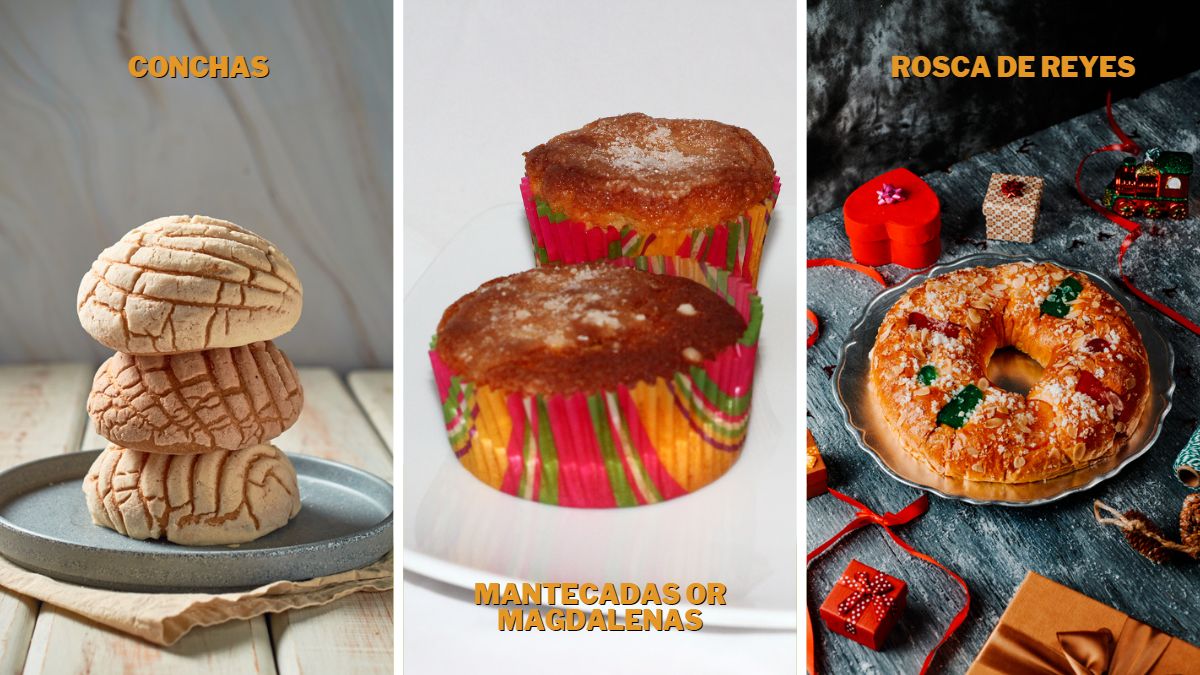
Novia
This is a traditional Mexican pastry prepared for a bride on her wedding day. It consists of layers with butter in between, representing layers of the wedding gown. If you’re not a bride, you can still enjoy these soft and sugary bread with a cup of tea on a regular day. They look like a big swirl, so it’s fun to eat them by unrolling.
Colchones De Naranja
Colchones are pillow-soft and airy pastries with orange relish. This is a rising dough, so you need time to rest. You can dust it with confection sugar or even glaze it with chocolate. Whether alone or with a dip, they are oh-so-tasty.
Trenza Danes
This braided pastry has that simple brioche-like dough, like many pans of dulce, soft and airy. It has a shiny golden glaze because of the yolk wash. It’s special because there is a creamy custard in the middle of it. It is usually vanilla-based, but fruity jams aren’t unusual at all.
Gusano
Gusano is a worm-shaped pastry filled with fruit cream and dusted with sesame seeds. Cinnamon and anise seeds spice the dough up, while the dough itself can be crumbly, flaky, or soft. When speaking of filling, it can be fruit jelly, cream, or custard.
How Many Types Of Sweet Bread Are There?
There are over 2,000 types of sweet bread, whatsoever. As mentioned above, Mexico alone has about 2,000 sorts of sweet bread, but examples from Italy, Scandinavia, and Japan abound in their versions, too. The rough estimation says there are circa 3000 types of sweet bread.
Almost every country in the world has one or more traditional recipes for sweet bread. Some are globally popular; others are well-kept secrets you’ll get to know only from locals. Also, wide varieties of the same bread have different names specific to the region in question.
You can never count them all, but you can divide them into groups, like holiday bread, breakfast, brunch, and tea pastries. Don’t be afraid to try different versions of sweet bread; you’ll undoubtedly find your perfect match.
Still, I would love to know which ones you’ve tried by now. How did you like them? Excited to read your thoughts in the comments below!
